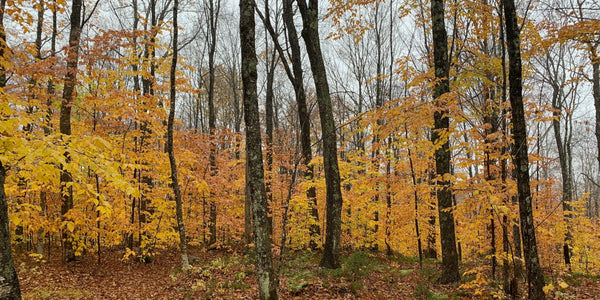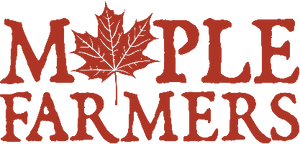Audubon Vermont’s Bird-Friendly Maple Project encourages the management of maple sugarbushes that improve habitat for songbirds. By fostering a diverse forest, maple farmers can provide an environment that is more welcoming to birds as well as mammals and amphibians. The end result is a more wildlife-friendly forest. As Audubon Vermont says, “Maple sugarbushes are inherently good for birds, but forests that are intentionally managed with birds in mind are even better!”
In late May I hiked into the sugarbush with Steve Hagenbuch, a conservation biologist with the National Audubon Society. We were there to survey the trees and document how well our maple sugarbush could support different songbirds. The data we collected was used to calculate how the sugarbush scored on the goals of bird-friendliness: a well-balanced mix of healthy and dead trees of all ages and sizes. This survey gives us a baseline to use as we manage the forest to ensure that it will become even more bird-friendly in the future.
Surveying the Maple Sugarbush
Steve and I stopped at a handful of random locations and surveyed the forest around us. We began by looking for large dead trees that were still standing. These ‘snags’ as they are called, offer habitat for birds and animals. Woodpeckers are attracted to them, and once trees are peppered with holes they become condominiums for other birds. In the past I saw snags as something that should be ‘cleaned up’. I now have a new appreciation for snags and their critical role in creating a bird-friendly environment.
In addition to snags, Steve also noted the mix and ages of tree species. A diverse mix of young and old trees encourages the forest to be more healthy and bird-friendly. He evaluated the percentage of tree canopy cover at three different heights from the ground. Steve explained that some songbirds like to live in the upper canopy of the trees, other species live in the middle of the trees, and some prefer the undergrowth closer to the ground. Having tree branches at all elevations in the forest is critical to healthy bird habitat.
Historical Maple Sugarbushes
In the early days of making Vermont maple syrup, farmers walked through the woods with a yoke as they collected and loaded maple sap into sleds that horses or oxen would pull back to the sugarhouse. Removing the undergrowth and small trees in a forest made it easier for the sugarmakers and their animals to maneuver in the sugarbush. Despite their park-like visual appeal, a monoculture of large sugar maple trees is not good bird and wildlife habitat. The birds need the underbrush to build their nests and forage for food.

A stand of nothing but mature maple trees is visually appealing, but not very bird-friendly.
Modern Maple Sugarbushes
In our modern times, tubing is used instead of sap buckets to collect sap from the trees for making maple syrup. Leaving the dead trees and underbrush in the forest is now feasible since the tubing runs through dense forests with relative ease. I am heartened to know that plastic in the maple syrup industry actually has some environmental benefit. Rather than cleaning out undergrowth, the shrubby and small trees can be left to the great benefit of the birds and animals. Allowing nature to run its course is the best thing we can do for our Vermont forests.

A mix of different tree species of different ages makes for good bird habitat.
To become a designated bird-friendly maple syrup operation, the land must have a forest management plan which encourages ways to increase the natural diversity of the forest to benefit birds. My sugarbush is owned by our neighbor Lynn who graciously lets me tap her trees. I am happy to say that the plan for the forest already includes wording such as “Leave two or three snags or cull trees per acre for woodpeckers and other cavity nesters, and coarse woody debris for amphibians.” Through proper management, the forest habitat will become even more bird-friendly over time.
I am proud to be part of this Bird-Friendly Maple Project. The process has opened my eyes in some new ways. I find joy in seeing a snag because I know is so much more than simply a dead tree. When I hear a new song in the woods, I know that perhaps I had a little something to do with that bird moving into the sugarbush.
At the time of this article in 2023, Maple Flower Farm in Bethel, Vermont is the only farm Certified Bird-Friendly with Audubon Vermont. The other farms in our collective do manage their sugarbushes in a way that encourages birds and wildlife. However, the program requires an official forest management plan that many of the small farmers do not have.

